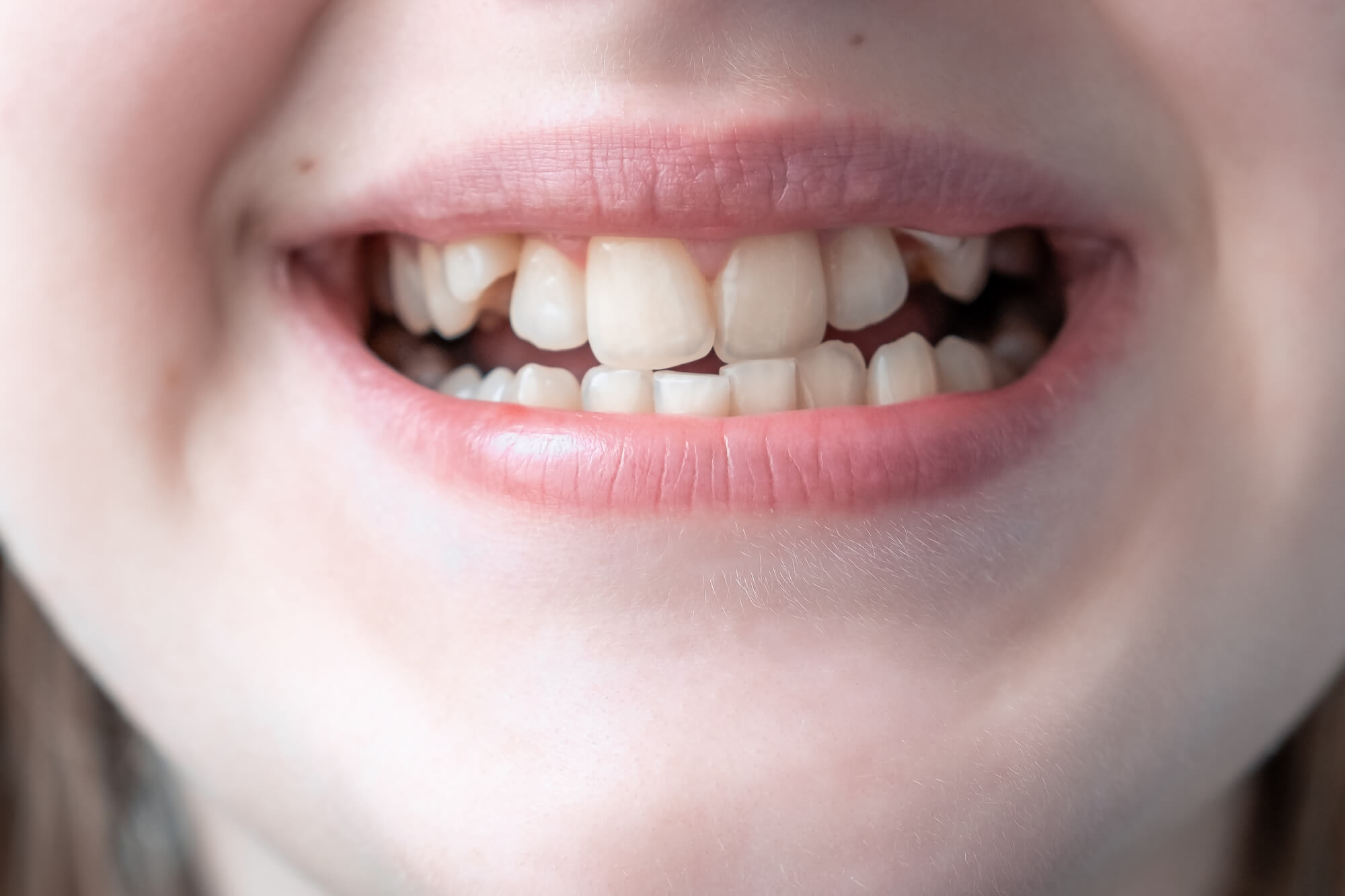
Types of Misalignment of Teeth that Alignify32 Can Fix
A confident smile can make a lasting first impression, open doors to opportunities, and boost your self-esteem. However, not everyone is naturally blessed with perfectly aligned teeth. Misaligned teeth, or malocclusion, are a common issue, but with the right treatment, you can achieve a beautiful smile.
Alignify32 offers a solution for many types of teeth misalignment, helping you achieve straight, balanced teeth while maintaining a discreet treatment process.
What is Malocclusion?
Malocclusion refers to a misaligned bite, where the teeth and jaws don’t fit together properly. This misalignment can make everyday activities like chewing and speaking difficult and may cause discomfort over time. Fortunately, malocclusions are treatable, and the treatment plan depends on the severity and type of misalignment.
Alignify32 can treat various types of malocclusions effectively. Here’s a breakdown of the most common types:
- Overbite or Deep Bite
- Crossbite or Reverse Bite
- Crowding
- Teeth Spacing
- Open Bite
- Excessive Overjet
Overbite or Deep Bite
What is a Deep Bite?
An overbite (also known as a deep bite) occurs when the upper front teeth overlap the lower front teeth too much. Ideally, the upper teeth should slightly overlap the lower teeth, with just a small gap. An overbite greater than 4 mm can cause functional problems such as the upper teeth biting into the lower lip or the lower teeth biting into the roof of the mouth.
How Alignify32 Treat Overbite (Deep Bite)?
Alignify32 is effective in treating overbites up to 4mm. The treatment involves extruding the back teeth (moving them up) and intruding the front teeth (moving them down). For severe cases (over 5mm), surgical intervention may be required alongside Alignify32 treatment.
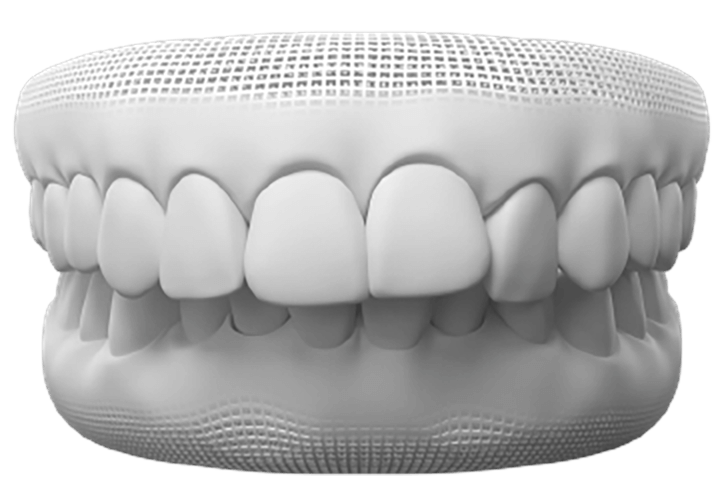
Cause of Overbite
- Genetics: The most common cause of an overbite is inherited from parents. If a family member has an overbite, there's a higher chance of it being passed down.
- Thumb Sucking: Extended thumb sucking during childhood can interfere with the natural development of the teeth and jaw, contributing to an overbite.
- Tongue Thrusting: The habit of pushing the tongue against the front teeth when swallowing or speaking can also lead to misalignment and an overbite.
- Early Loss of Baby Teeth: Premature loss of baby teeth can cause the surrounding teeth to shift, leading to a misaligned bite, including an overbite.
- Jaw Development Problems: Problems with how the upper and lower jaws grow can also contribute to an overbite. For example, if the upper jaw grows too far forward or the lower jaw doesn’t develop enough, an overbite can result.
- Prolonged Use of Pacifiers: Like thumb sucking, excessive use of pacifiers can affect the development of teeth and the jaw, leading to bite problems.
- Dental Issues: In some cases, crowded teeth, tooth loss, or poorly placed dental work can also lead to an overbite.
- Other Habits: Mouth breathing or improper dental care might exacerbate the condition.
Why Treat Overbite?
- Wear and Tear: An overbite can lead to uneven pressure on the teeth, which may cause excessive wear, chipping, or cracking over time.
- Tooth Decay and Gum Disease: If the teeth are misaligned, it can be harder to clean them properly, increasing the risk of cavities and gum disease.
- Jaw Pain: An overbite can place extra strain on the jaw joint (TMJ), leading to discomfort, pain, and issues with jaw movement.
- Chewing and Biting: A properly aligned bite ensures that your teeth come together correctly when you chew, making it easier to break down food. An overbite can cause difficulty in biting or chewing properly.
- Speech: Severe overbites may interfere with speech patterns, causing difficulties in pronouncing certain words or sounds.
- Preventing Further Problems: Over time, an untreated overbite may lead to more severe bite problems, including issues with the alignment of your jaw, increased risk of tooth misalignment, and difficulty with proper jaw movement.
- Aesthetic Considerations: Many people choose to treat their overbite for cosmetic reasons. A more balanced, symmetrical smile can enhance your appearance and boost confidence.
- Preventing Headaches and Jaw Issues: Misalignment caused by an overbite can lead to temporomandibular joint (TMJ) disorder, which may cause headaches, jaw pain, and other discomforts.
- Improved Overall Quality of Life: Correcting an overbite can lead to better self-esteem and comfort. It can reduce physical discomfort and improve your ability to perform basic tasks like eating, talking, and even smiling.
Crossbite (Reverse Bite)
What is a Crossbite?
A crossbite occurs when some of the upper teeth are positioned inside the lower teeth, either on the front or side of the mouth. This misalignment can lead to tooth wear, gum recession, and even bone loss if not corrected.
How Alignify32 Treat Crossbite?
Alignify32 can gradually shift the teeth into proper alignment by using clear aligners that move the teeth into their desired position. The treatment plan will address both the upper and lower arches, ensuring that the teeth meet correctly.
Types of Crossbite
- Anterior Crossbite
- Posterior Crossbite
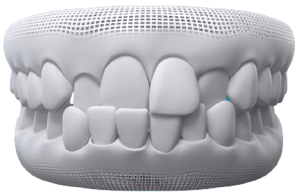
What is a Anterior Crossbite (Underbite)?
An anterior crossbite occurs when the lower front teeth are positioned further forward than the upper front teeth. Essentially, the lower teeth are ahead of the upper teeth, causing the upper teeth to bite inside the lower teeth. This can result in an improper bite alignment that may cause jaw discomfort, teeth wear, and difficulty in chewing and speaking.
How Anterior Crossbite is Treated with Alignify32?
Alignify32 can help correct an anterior crossbite by gradually shifting the lower front teeth back into place and moving the upper teeth forward into their proper position. The aligners apply gentle pressure on the teeth, moving them into alignment over time.
Alignify32 treatment is customized to the patient’s specific dental structure, ensuring precise and effective results. Typically, this treatment is non-invasive, using clear plastic aligners to shift the teeth into their correct alignment without the need for traditional metal braces.
What is Posterior Crossbite?
A posterior crossbite involves the back teeth, where one or more upper teeth bite inside the lower teeth. This misalignment can affect the upper molars or premolars and may cause issues with jaw alignment and tooth wear.
How Posterior Crossbite is Treated with Alignify32
For a posterior crossbite, Alignify32 will work to reposition the upper back teeth, shifting them into proper alignment with the lower teeth. In some cases, additional orthodontic procedures may be necessary to address underlying issues, such as jaw discrepancies. Alignify32 provides a comfortable and discreet solution to fix posterior crossbite without the need for traditional braces.
Why Correct Crossbite?
A crossbite or underbite can lead to a range of dental and functional issues, including:
- Teeth wear and enamel erosion: Misaligned teeth can rub against each other abnormally, causing wear and damage to tooth surfaces.
- Gum recession: Crossbite can contribute to gum irritation and lead to recession.
- Jaw pain and discomfort: Misaligned bites often cause uneven pressure on the jaw, leading to pain, discomfort, or even TMJ issues.
- Difficulty in chewing and speaking: A crossbite can affect normal chewing and speaking functions, potentially causing discomfort during daily activities.
Alignify32: Your Solution for Crossbite
Alignify32 offers a discreet, effective, and comfortable solution for correcting crossbites and improving your smile. With clear aligners that are custom-made to your needs, Alignify32 provides a hassle-free treatment option that aligns your teeth with precision.
- Invisible and comfortable: The aligners are virtually invisible, making them a discreet option for treatment. They are also comfortable, designed to fit snugly over your teeth.
- Removable: You can easily remove your aligners when eating, drinking, brushing, or flossing, allowing for easier maintenance of oral hygiene.
- Customized treatment plan: Alignify32 provides a tailored plan that’s designed specifically for your misalignment, ensuring optimal results.
Crowding
What is a Crowding?
Crowding happens when there isn’t enough space for teeth to grow in straight, causing them to overlap, twist, or shift. This can make it difficult to clean your teeth properly, leading to a higher risk of cavities and gum disease.
How Alignify32 Treat Crowding?
Alignify32 can help reduce crowding by gradually shifting teeth into their proper position. In some cases, interproximal reduction (IPR) may be necessary to create space between the teeth for proper alignment.
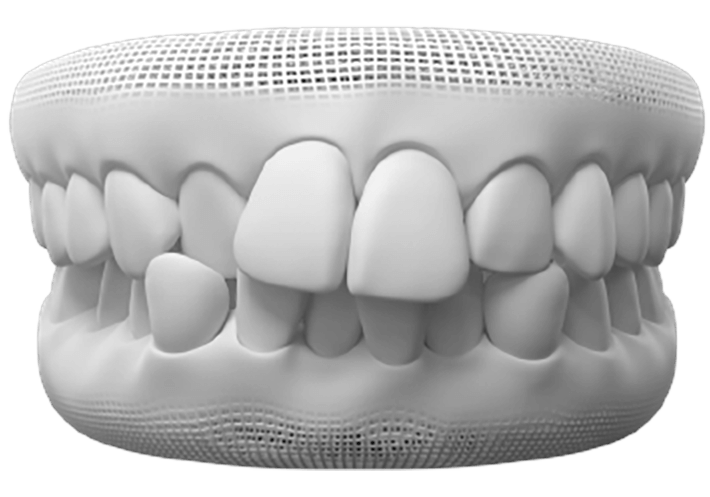
Causes of Dental Crowding:
- Genetics: Larger teeth in a smaller jaw can lead to crowding.
- Premature loss of baby teeth: Early loss of baby teeth can lead to neighboring teeth shifting into the empty space, affecting the eruption of permanent teeth.
- Over-retained baby teeth: When baby teeth don’t fall out as expected, they can prevent permanent teeth from emerging properly.
Why Treat Overbite?
- Harder to Clean Teeth: When teeth are crowded, they overlap or are positioned too close together, making it difficult to brush and floss properly. This increases the risk of plaque buildup, cavities, and gum disease.
- Harder to Clean Teeth: Poor cleaning due to crowded teeth can lead to gingivitis or more serious gum disease, which can result in tooth loss if left untreated.
- Increased Wear and Tear: Crowded teeth may not come together correctly when biting, leading to uneven pressure on the teeth. This can cause abnormal wear, chipping, or even tooth fractures over time.
- Tooth Shifting: Over time, teeth can continue to shift and worsen in their alignment, making it harder to correct them in the future.
- Biting and Chewing: Misaligned teeth due to crowding can make it difficult to chew properly, affecting digestion and possibly causing jaw discomfort.
- Speech: Severely crowded teeth can also interfere with speech, especially when teeth block certain sounds or make it difficult to pronounce words correctly.
- TMJ Issues: Crowding can lead to improper alignment of the teeth and jaw, which might contribute to temporomandibular joint (TMJ) disorders. This can cause pain in the jaw, headaches, or difficulty in opening/closing the mouth.
- Overbite/Underbite: Crowded teeth often contribute to the development of bite problems, such as overbites or underbites, which can lead to further complications.
- Improved Smile: Correcting crowded teeth can enhance the appearance of your smile. Straight, properly aligned teeth are often associated with better aesthetics and can improve your self-confidence.
- Symmetry: Crowded teeth can make your smile appear uneven, which might affect your overall facial appearance. Correcting them can give you a more symmetrical and balanced look.
- Preventing Future Problems: Addressing crowding early can prevent it from leading to more serious issues later, such as tooth loss or more complex orthodontic treatments.
- Better Overall Dental Care: Once your teeth are properly aligned, it’s easier to maintain oral health with regular brushing, flossing, and dental checkups.
- Tooth Eruption Issues: Crowded teeth can block the eruption of other teeth, potentially causing misalignment or even impaction in adult teeth.
- Increased Risk of Tooth Decay: Overlapping teeth can trap food and bacteria, increasing the chances of cavities in areas that are hard to reach with regular cleaning.
Teeth Spacing
What is Teeth Spacing (Diastema)?
Teeth spacing occurs when there are gaps between the teeth, commonly seen in the upper front teeth. While this can be purely aesthetic, it may also lead to functional issues, such as difficulty chewing or speaking.
How Alignify32 Treat Spacing?
Alignify32 can effectively close gaps between teeth by gradually shifting them together. This is done through custom aligners that apply gentle, controlled pressure to move the teeth into alignment.
Causes of Teeth Spacing:
- Missing Teeth
- Small Teeth
- Tongue Thrusting
- Prolonged Thumb Sucking
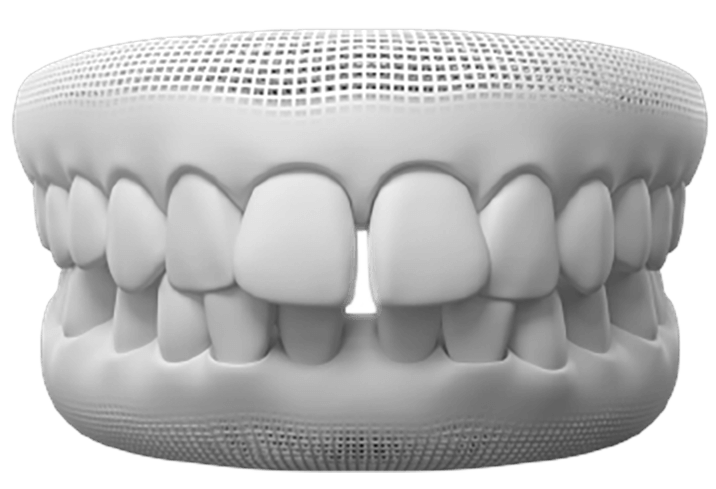
Why Treat Teeth Spacing?
- Improved Oral Hygiene: Gaps between teeth can make it easier to clean your teeth thoroughly, reducing the risk of plaque buildup, cavities, and gum disease. Proper alignment helps in maintaining a cleaner mouth.
- Better Aesthetic Appearance: Closing gaps between teeth can enhance your smile, leading to improved self-confidence and better facial aesthetics.
- Prevention of Tooth Shifting: Gaps can cause adjacent teeth to shift and become misaligned over time, which may lead to further bite problems and misalignment.
- Improved Functionality: Closing gaps can improve the function of your teeth, allowing for better biting, chewing, and speaking. Misaligned teeth can cause difficulty in these functions.
- Prevention of Jaw Issues: Misalignment from spacing issues can lead to jaw strain and discomfort, sometimes contributing to temporomandibular joint (TMJ) disorders.
- Reduced Risk of Gum Disease: Gaps between teeth can collect food and plaque, increasing the risk of gum irritation and periodontal disease. Treating the spacing makes it easier to clean effectively.
- Improved Long-Term Oral Health: Treating teeth spacing early can prevent the development of more serious dental issues, such as misalignment or tooth decay, and allow for easier maintenance of oral health.
Open Bite
What is Open Bite?
An open bite occurs when the upper and lower teeth do not meet when the mouth is closed, leaving a gap in the bite. This misalignment can affect your ability to chew, speak, and sometimes even cause jaw pain.
How Alignify32 Treat Open Bite?
Alignify32 can close an open bite by moving the teeth into proper alignment. The treatment plan will focus on shifting the front and/or back teeth to eliminate the gap and restore normal function.
Types of Open Bite
- Anterior Open Bite
- Posterior Open Bite
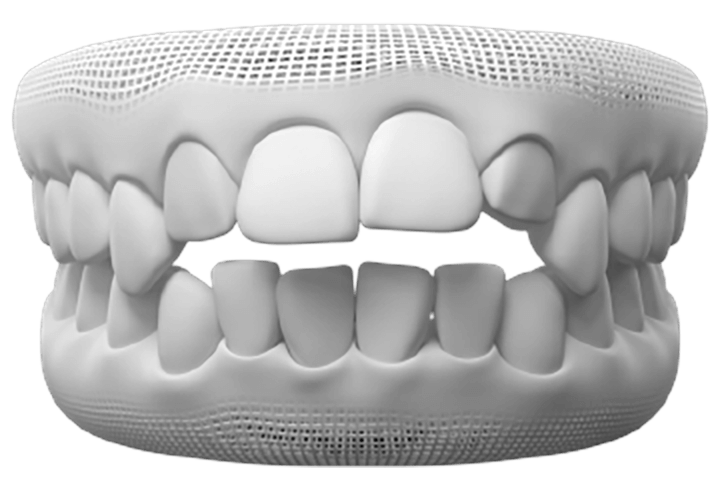
What is Anterior Open Bite?
Affects the front teeth, where the upper and lower front teeth do not meet.
What is Posterior Open Bite?
Affects the back teeth (molars and premolars), preventing them from touching when biting down, leading to difficulty in chewing.
Cause of Open Bite?
- Thumb Sucking: Prolonged thumb sucking, especially in childhood, can push the upper front teeth outward, leading to an open bite.
- Tongue Thrusting: Habitual tongue thrusting, where the tongue pushes against the teeth during swallowing or speaking, can cause the teeth to shift and create an open bite.
- Genetics: An open bite can be inherited from family members. The size and structure of the jaw and teeth can contribute to this condition.
- Jaw Size Discrepancies: If the upper or lower jaw is too large or too small, it can cause the teeth to misalign, creating an open bite.
- Prolonged Use of Pacifiers: Extended pacifier use beyond infancy can push the teeth into incorrect positions, potentially leading to an open bite.
- Early Loss of Baby Teeth: Losing baby teeth too early can cause surrounding teeth to shift, which may lead to an open bite if the permanent teeth haven't fully erupted.
- Mouth Breathing: Consistently breathing through the mouth, instead of the nose, can affect the alignment of the teeth and contribute to an open bite.
- Dental or Facial Injury: Injuries to the face or teeth can cause misalignment, leading to an open bite if the jaw or teeth are displaced.
- Cleft Lip or Palate: Congenital conditions such as cleft lip or palate can affect the development of the teeth and jaw, resulting in an open bite.
- Poor Dental Restorations or Orthodontic Treatment: Incorrectly placed fillings, crowns, or past orthodontic work can lead to an open bite if the teeth don't align properly afterward.
- Teeth Grinding (Bruxism): Severe teeth grinding or clenching can cause the teeth to shift out of alignment, potentially contributing to an open bite.
- Habitual Chewing on Objects: Chewing on non-food items like pens or pencils can place pressure on the teeth in unnatural ways, leading to an open bite.
Why Treat Open Bite?
- Improved Chewing and Biting Function: An open bite can make it difficult to bite and chew properly, which can affect digestion and overall nutrition. Treating the condition restores proper biting function.
- Prevent Jaw Strain and Discomfort: An open bite can put undue stress on the jaw muscles and joints, leading to pain, discomfort, and potential TMJ (temporomandibular joint) issues. Treatment can alleviate this strain.
- Improved Speech: An open bite can impact speech by making it difficult to pronounce certain words. Correcting the bite can improve speech clarity and pronunciation.
- Prevention of Tooth Wear and Damage: When teeth don’t align properly due to an open bite, uneven pressure is placed on the teeth, which can lead to excessive wear, chipping, or fractures. Treatment can prevent this damage.
- Better Aesthetic Appearance: Closing the open bite can improve the appearance of your smile, helping you feel more confident and enhancing facial aesthetics.
- Reduced Risk of Gum Disease and Tooth Decay: Misaligned teeth caused by an open bite can make it harder to clean your teeth effectively, increasing the risk of plaque buildup, cavities, and gum disease. Treatment can make oral hygiene easier and more effective.
- Preventing Further Dental Issues: If left untreated, an open bite can lead to more severe alignment issues and bite problems, which may require more complex and expensive treatments down the line. Treating it early can prevent these complications.
- Improved Overall Oral Health: Treating an open bite restores proper alignment, improving the overall health of the teeth and gums and reducing the risk of long-term dental issues.
Overjet
What is Excessive Overjet?
Excessive overjet refers to the horizontal overlap of the upper teeth over the lower teeth. It can cause difficulty in chewing and may lead to jaw discomfort or wear on the teeth.
How Alignify32 Treat Excessive Overjet?
Alignify32 can treat excessive overjet by gradually shifting the upper teeth backward and/or the lower teeth forward, helping them align properly and restore a functional bite.
Types of Overjet:
- Retrognathic Overjet
- Prognathic Overjet
- Functional Overjet
- Non-Functional Overjet
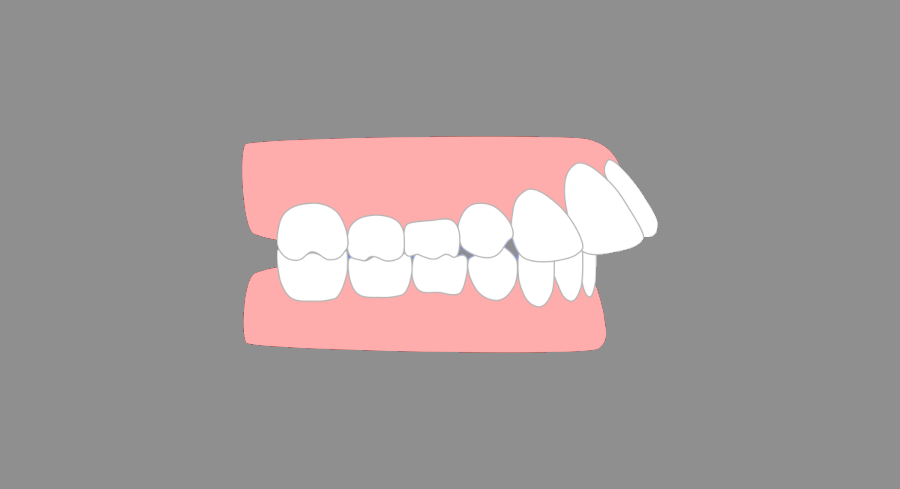
Problems Caused by Excessive Overjet
- Tooth Wear and Damage: An excessive overjet can lead to uneven pressure on the teeth, causing abnormal wear, chipping, or even tooth fractures, particularly in the upper front teeth.
- Increased Risk of Dental Injury: With an overjet, the upper front teeth protrude, making them more susceptible to trauma or injury from accidents, falls, or contact sports.
- Difficulty in Biting and Chewing: Excessive overjet can make it difficult to bite food properly, leading to inefficient chewing and potential digestive issues. This can also cause discomfort while eating.
- Speech Problems: A significant overjet can interfere with normal speech, particularly when pronouncing certain sounds or words, which can affect communication.
- Jaw Pain and Discomfort: An excessive overjet can strain the jaw muscles and temporomandibular joint (TMJ), leading to pain, discomfort, or even temporomandibular joint disorders (TMD).
- Increased Risk of Gum Disease: Misaligned teeth due to overjet make it harder to clean teeth properly, increasing the risk of plaque buildup, gum disease, and cavities.
- Psychological and Social Impact: A pronounced overjet may negatively affect a person’s appearance, leading to self-consciousness, lack of confidence, and potential social or psychological issues.
- Worsening Bite Problems: If left untreated, an excessive overjet can worsen over time, leading to more severe bite issues such as misalignment, overbite, or underbite, which could require more complex treatments.
Why Treat Overjet?
- Improved Functionality: An overjet can cause difficulty in biting and chewing properly, which can affect nutrition and lead to jaw discomfort. Treatment restores proper biting function and overall efficiency.
- Prevention of Tooth Damage: An overjet can lead to uneven pressure on the teeth, resulting in abnormal wear, chipping, or potential tooth fractures. Treating the overjet can prevent these issues.
- Reduced Risk of Gum Disease and Tooth Decay: Misaligned teeth due to an overjet make it harder to clean them effectively, increasing the risk of plaque buildup, cavities, and gum disease. Treatment improves oral hygiene and reduces these risks.
- Improved Aesthetic Appearance: Treating an overjet can enhance your smile by aligning the teeth properly, which boosts confidence and improves overall facial aesthetics.
- Prevent Jaw Strain and Discomfort: An overjet can put extra strain on the jaw muscles and temporomandibular joint (TMJ), leading to pain, discomfort, and jaw clicking. Treatment can alleviate this strain and prevent further issues.
- Improved Speech: A significant overjet can affect speech, especially when pronouncing certain words or sounds. Treating the condition can lead to clearer, more natural speech.
- Reduced Risk of Injury: Individuals with a significant overjet are at a higher risk of dental trauma, especially to the front teeth. Treating an overjet can help reduce the likelihood of injury, particularly in accidents or contact sports.
- Better Long-Term Oral Health: Correcting an overjet early can help avoid more complex dental problems in the future, improving overall oral health and preventing further alignment or bite issues.
Impected Tooth
What is Impacted Tooth?
An impacted tooth is a tooth that is unable to emerge from the gums naturally, often leading to misalignment of neighboring teeth. The most commonly impacted teeth are the permanent canines.
How Alignify32 Treat Impacted Tooth?
Alignify32 can be used to align the teeth and, in cases of impacted teeth, may be combined with procedures like tooth extraction or exposing the impacted tooth so that braces can gradually move it into position.
Types of Impected Tooth:
- Mesial Impaction
- Distal Impaction
- Vertical Impaction
- Horizontal Impaction
- Buccal Impaction
- Distal Impaction
- Lingual Impaction
- Partial Impaction
- Full Impaction
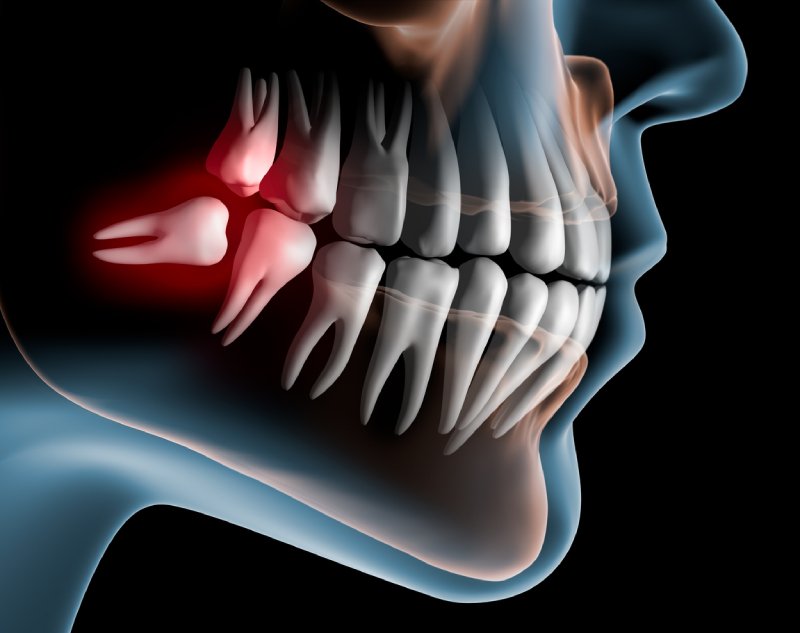
Problems Caused by Impected Tooth?
- Pain and Discomfort: Impacted teeth can cause significant pain, especially if they become infected or put pressure on nearby teeth, gums, and nerves.
- Infection Risk: Impacted teeth can create pockets in the gums, leading to bacterial infections, which can cause swelling, pus, and more severe oral health issues.
- Damage to Adjacent Teeth: Impacted teeth can push against neighboring teeth, causing misalignment, root resorption, or even damage to the adjacent tooth structure.
- Gum Disease: The presence of an impacted tooth can make it difficult to clean around the affected area properly, leading to plaque buildup, gum disease, and periodontal problems.
- Abscess Formation: Impacted teeth can lead to the formation of abscesses or cysts, which may require surgical intervention to remove the infection and prevent damage to surrounding bone or tissue.
- Bad Breath: Due to trapped food particles and bacteria around the impacted tooth, persistent bad breath (halitosis) can develop.
- Oral Hygiene Challenges: Impacted teeth, especially wisdom teeth, are hard to clean properly, leading to plaque buildup and making it difficult to maintain good oral hygiene.
- Misalignment of Other Teeth: Impacted teeth can cause shifts in the alignment of other teeth, leading to crowding or other bite problems.
- Headaches and Jaw Pain: The pressure caused by impacted teeth can lead to discomfort in the jaw, as well as frequent headaches or even ear pain.
- Difficulty Opening the Mouth: In some cases, impacted teeth can cause restricted mouth opening or jaw stiffness due to inflammation or pressure on the jaw muscles.
Why treat Impected Tooth?
- Relieve Pain and Discomfort: Treating an impacted tooth can alleviate the pain and discomfort caused by pressure on surrounding teeth, nerves, and gums.
- Prevent Infection: An impacted tooth can lead to infections in the surrounding tissue, gums, or even the jawbone. Treatment can help prevent or eliminate these infections, reducing the risk of abscesses or cysts.
- Avoid Damage to Adjacent Teeth: An impacted tooth can damage neighboring teeth by exerting pressure on them, leading to misalignment, decay, or even tooth fractures. Treating the impacted tooth can protect adjacent teeth from damage.
- Improve Oral Hygiene: Impacted teeth, especially wisdom teeth, are difficult to clean, which can lead to plaque buildup and gum disease. Treating the impacted tooth allows for easier cleaning and better oral health.
- Prevent Gum Disease: Impacted teeth create pockets in the gums, which can trap food particles and bacteria. This makes it difficult to maintain proper oral hygiene, leading to an increased risk of gum disease. Treatment helps prevent these problems.
- Improve Bite Alignment: Impacted teeth can cause crowding or misalignment of other teeth, which can affect your bite. Treating the impacted tooth restores proper alignment, improving overall dental function and appearance.
- Reduce the Risk of Headaches and Jaw Pain: Impacted teeth can cause strain and discomfort in the jaw, leading to headaches or jaw pain. Treatment can relieve these symptoms and prevent them from worsening.
- Prevent Long-Term Oral Health Issues: Left untreated, an impacted tooth can lead to more serious oral health problems, including chronic infections, abscesses, or bone loss. Treatment can prevent these complications and ensure better long-term oral health.
- Address Bad Breath: Impacted teeth can trap food particles and bacteria, leading to persistent bad breath. Treating the impacted tooth helps improve breath freshness and overall oral hygiene.
- Facilitate Dental Procedures: In some cases, an impacted tooth must be treated before undergoing other dental procedures, such as orthodontic treatment or the placement of dental implants, to ensure proper oral health and alignment.
Causes of Malocclusions
The most common causes of malocclusions (misalignments) include:
- Genetics: Inherited traits often lead to misaligned teeth and jaw structures.
- Early loss of milk teeth: Can cause neighboring teeth to shift, impacting the alignment of permanent teeth.
- Prolonged thumb-sucking or pacifier use: These habits can alter the position of the teeth and jaw.
- Cleft lip and palate: Can affect the development of teeth and jaw.
- Injuries or trauma: Damage to the teeth or jaw can lead to misalignments.
- Impacted teeth: When teeth cannot emerge properly, they can cause misalignment.
Symptoms of Malocclusions
Symptoms vary depending on the severity of the malocclusion, but common signs include:
- Misaligned teeth
- Difficulty chewing or biting
- Speech problems
- Difficulty breathing through the mouth
- Frequent biting of the tongue or cheeks
- Jaw pain or discomfort
- Changes in facial structure
Why Choose Alignify32?
Alignify32 provides an effective, comfortable, and virtually invisible solution for correcting a wide range of malocclusions. These aligners are:
- Discreet: Virtually invisible, allowing you to continue with your daily life without the noticeable appearance of traditional braces.
- Removable: You can remove the aligners while eating, drinking, brushing, or flossing, giving you more flexibility.
- Customizable: Alignify32 are tailored to your unique dental needs, ensuring a precise fit and effective treatment.
Investing in Your Smile
Investing in Alignify32 is a one-time commitment that can provide you with a lifetime of benefits, including improved self-confidence, better oral function, and a beautiful smile. Just like celebrities, you too can achieve the smile you’ve always dreamed of, without compromising your daily life.
Whether your teeth are crowded, spaced, or misaligned, Alignify32 offers a clear and effective solution to straighten your teeth and enhance your smile.
Don't wait any longer—take the first step towards a more confident you with Alignify32!
Conclusion
If you’re experiencing any of these orthodontic issues, don’t hesitate to book a consultation with an Alignify32 provider. Our team of professionals will provide a detailed assessment and help you create a personalized treatment plan for a healthier, more beautiful smile. Let us help you correct your malocclusions with safe, effective, and long-lasting results.

